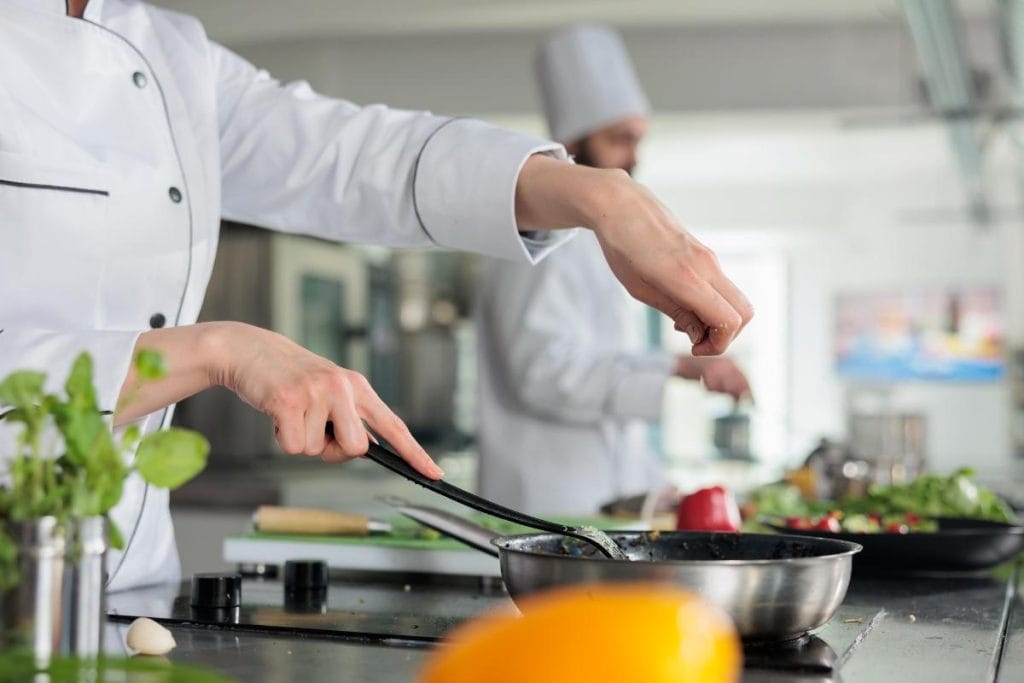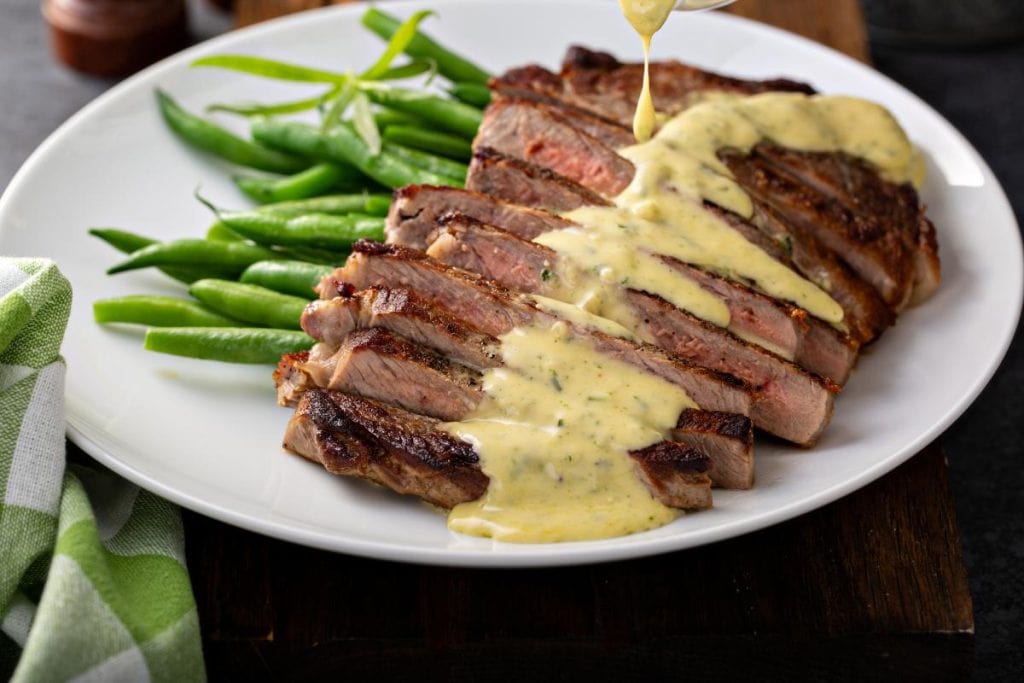
Ever caught yourself lost in thought, daydreaming about the perfect poached egg or getting lost in the aroma of a simmering stock?
If so, chances are your diners have too. Meaning, to truly impress, you’ll need to master recipes that transport people to a Michelin-starred restaurant with every bite you serve.
How, you ask?
Well, for starters, by understanding that cooking is not just about following a recipe. It’s about truly understanding the ingredients and techniques needed to create unforgettable dishes.
Whether it’s the delicate balance of flavors in a sauce or the precise timing required to cook a protein to perfection, every detail counts.
So, roll up your sleeves, sharpen your knives, and let’s get into the essential recipes every aspiring sous chef should master!
1. Stocks and Sauces

“An ounce of sauce covers a multitude of sins” said Anthony Bourdain, a legend of the culinary world.
And boy, would anyone who’s ever tried a perfectly seared steak with béarnaise sauce agree!
Stocks and sauces form the backbone of countless dishes, providing depth to hearty dishes, as well as richness and complexity to flavors.
A well-prepared stock can elevate a humble chicken noodle soup into a gourmet experience, while a perfectly balanced sauce can transform an ordinary dish into an extraordinary one.
Just imagine biting into a perfectly poached egg, its golden yolk oozing out and mixing with the creamy richness of a Hollandaise sauce. Or think about how a simple stock made of beef bones and a medley of vegetables like carrots, celery, onions, and leeks transforms an ordinary stew into a flavorful pot-au-feu.
It’s the stuff dreams are made of – simple ingredients, transformed into extraordinary dishes by the skillful hands of a chef.
So, get to know the techniques behind these culinary essentials and watch your dishes come alive with flavor and depth.
2. Sous-Vide Protein Cooking and Searing
Sous-vide cooking is as much a science as it is an art in the modern culinary world.
This technique has breathed new life into traditional dishes, elevating them to new heights of flavor and texture.
Take, for example, the Japanese “onsen eggs,” traditionally prepared by gently cooking eggs in the natural heat of hot springs. Sous-vide replicates this gentle cooking method, resulting in eggs with a silky, custard-like texture that perfectly complements a variety of dishes.
However, egg recipes are not the ones where this technique truly shines.
Sous-vide is a game-changer for sous chefs looking to achieve consistent, restaurant-quality results with meat proteins. The precise temperature control ensures that even tough cuts like short ribs and pork belly turn out tender and juicy, edge to edge.
And remember: once your proteins are done taking a sous-vide bath, don’t rush with serving them just yet. Give them a quick sear in a hot pan or on a grill to add a beautiful caramelization and depth of flavor to the meat.
You know it’s that irresistible crispy exterior that has guests coming back for more!
3. Bread and Pastry Doughs

You know those quotes about how happiness is the smell of freshly baked bread?
Well, we totally agree.
There’s something truly magical about the aroma of bread and pastry doughs as they bake, filling the kitchen with warmth and anticipation.
And it’s not just bread that makes people feel all warm and fuzzy. People tend to feel the same way about the irresistible scent of buttery croissants wafting through a bakery, or the savory aroma of a pizza fresh from the oven, laden with gooey cheese and flavorful toppings.
So, if you want your meals to make people feel as if they’re wrapped in a warm hug, here are the first two things you need to learn about:
- Fermentation; and
- Dough preparation for pastries.
Get your own sourdough starter going and master the art of handling pastry dough to avoid developing too much gluten.
Once you nail that, you’ll be making more than just ordinary dishes. You’ll be making culinary institutions.
4. Pasta and Rice Dishes
Whenever we indulge in a truly authentic Italian pasta dish, Pasta Queen’s famous phrase, “Just gorgeous,” echoes in our minds.
Because that’s exactly how everyone feels when they bite into a perfectly al dente pasta or savor a spoonful of perfectly cooked risotto.
These two dishes are an essential part of any sous chef education, as they are beloved worldwide and form the cornerstone of practically every cuisine there is.
From Italy’s Pasta Carbonara, originally a hearty meal for charcoal workers, to Japan’s delicate sushi and comforting onigiri, pasta and rice dishes have always offered a canvas for cultural expression.
So, how can you truly make a difference in these dishes?
Well, for starters, be careful not to overcook your pasta. Cook it just enough to be firm to the bite and so that it holds up well to the sauce.
For rice dishes like risotto, the technique lies in achieving the perfect creamy consistency without overcooking the rice. Add your liquids to the rice gradually, allowing it to absorb slowly and release its starches.
Okay, now we’re getting hungry.
5. Classic French Vegetable Preparations

Whoever hates vegetables and thinks they’re boring, they’ve never tried Ratatouille.
This classic French dish is a celebration of summer vegetables, including tomatoes, zucchini, eggplant, and bell peppers. It is a prime example of how simple vegetable preparations can come together to create a flavorful and satisfying dish.
Now, the key is to treat vegetables with the same care and attention as meats and fish.
From blanching to steaming and glazing, sous chefs use these methods to elevate vegetables to new heights, preserve their natural flavors and textures, and enhance their visual appeal.
Also, keep things simple. The point is to bring out what’s already the best in vegetables, such as their natural sweetness and freshness.
So, whether it’s the vibrant green of blanched asparagus or the tender-crisp texture of steamed carrots, these preparations are all about letting the vegetables shine.
6. Fish and Seafood
When Polish folks said, “Fish, to taste right, must swim three times – in water, in butter, and in wine,” they were onto something big.
But, before even thinking about cooking fish and seafood, sous chefs must learn how to handle these delicate ingredients with care.
The first skill every sous chef should master is fish filleting. Otherwise, they risk ending up with a dish that’s more bones than fillet!
Then, a sous chef must learn how to cook fish and seafood to the perfect temperature, which is an art in itself. Overcooking can result in dry, tough fish, while undercooking can lead to foodborne illnesses.
Only after mastering these skills, you can get to making your very first French sole meunière.
Now that we have your mouth watering and your culinary curiosity piqued, we’ve got only one question for you:
Are you ready to take your culinary journey to the next level?
If you are, dive into these essential recipes and start your search for sous chef jobs today to turn your passion into a fulfilling career!
